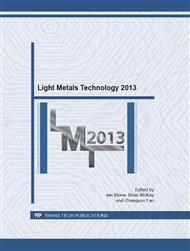p.554
p.558
p.563
p.568
p.574
p.580
p.585
p.590
p.597
Fatigue Crack Growth in Cast and Wrought Aluminium Alloys
Abstract:
Fatigue crack growth (FCG) behaviour of cast aluminium alloys with different strengthening mechanisms (A535, 319, A356, A390) and wrought aluminium alloys (6061) was investigated in this study. Among the various parameters that can affect the propagation of fatigue cracks, the initial flaw size and microstructure were studied and correlated. Long and small FCG tests at low and high positive stress ratios were conducted on these materials in room temperature air. The mechanisms of FCG at the microstructural scale were identified and will be compared and discussed. In addition, two-parameter design diagrams were constructed to link loading conditions to microstructural response and fracture modes determined from fractographic observations. Finally, a new methodology and tools that can be used to bridge the differences between small and long fatigue cracks were developed and will be presented.
Info:
Periodical:
Pages:
574-579
Citation:
Online since:
July 2013
Authors:
Price:
Сopyright:
© 2013 Trans Tech Publications Ltd. All Rights Reserved
Share:
Citation:


